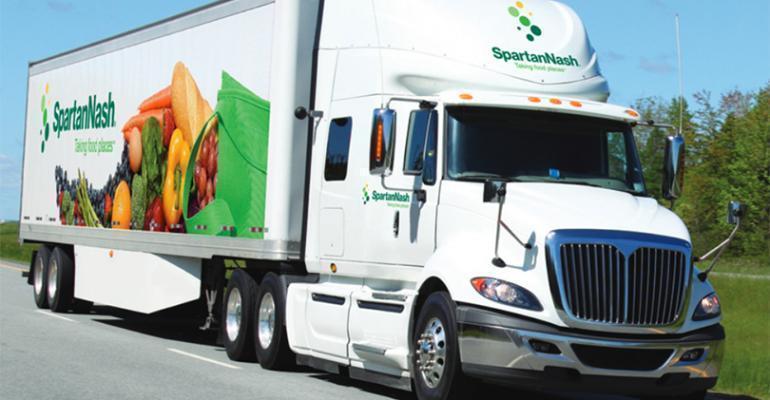Tony Sarsam has been at the helm of SpartanNash as president and CEO since September 2020. He brought a deep background in CPG to the Grand Rapids, Mich.-based grocery distributor and retailer, previously serving as Borden Dairy CEO and, prior to that, as Ready Pac CEO and president of Nestlé USA’s direct-store delivery arm. He also held sales and operations roles at Dreyer’s Grand Ice Cream and spent over 20 years at PepsiCo, most recently in the Frito-Lay unit.
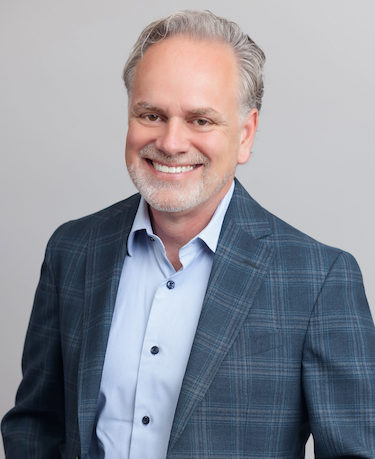
Sarsam (left) came to SpartanNash in a time of change, about six months into the COVID-19 pandemic, which has shifted consumers’ eating and shopping behaviors and pushed food retailers and wholesalers to rethink their operations and more tightly embrace e-commerce. To that end, he is rallying the company around core capabilities to drive a defined set of strategic priorities that will carry the business into the future.
Through its core food distribution segment, SpartanNash distributes to all 50 states, supplying 145 corporate-run supermarkets in nine Midwestern states — which make up its retail business unit — and over 2,100 independent grocery retailers nationwide. The company also distributes to 160 military commissaries and over 400 exchanges in United States and internationally. Supermarket News Senior Editor Russell Redman recently talked with Sarsam about the company’s strategic aims, as well as operating in today’s difficult economic climate. Here are edited excerpts of the discussion.
SUPERMARKET NEWS: How would you describe the current business environment for grocery wholesalers and retailers, and how well is SpartanNash weathering these conditions?
TONY SARSAM: Well, the environment is unprecedented in our careers, for sure. Right? There were times back in the early part of the 20th century where there were a lot of real oddities in the overall environment. But if you look at the last 40 or 50 years, there has been nothing like this, the combination of a global pandemic, how that immediately impacted consumer habits and the follow-on elements of being prepared for that and what happened with policy that drove labor shortages in the marketplace and dealing with that. And then the labor shortages leading into 40-plus-year highs in inflation. So all those components are really unique and almost uniquely settling in with folks in the grocery business.
So we’re juggling all that. And I would say to answer the second part of your question, how is the team dealing with that, the team has been spectacular. If you go back to March of 2020, there was a great deal of confusion about what was going to happen next [with COVID-19]. We didn’t know much about the disease, how it would manifest and how it would change our world. A lot of folks that I know in other industries had at least a assumed the option of heading into their basement and waiting things out. Every single person in my organization came to work that next day. There’s a sense of vocation, I think, in the food industry and in the retailing industry. We need to keep the country fed; this is what we do. We didn’t deal with any gaps in terms of commitment from that day forward. The team has still wrestled and, I think, struggled heroically with shortages in labor that caused them to work overtime and their lives to be less predictable — but unwavering in their commitment to their communities and to the company. So I’ve been extraordinarily proud of the work that our team has done.
SN: As a distributor, SpartanNash has really been in the middle, seeing a lot of the supply-side impact and the retail impact, also as an operator of grocery stores.
SARSAM: That’s exactly right.
SN: In the recent analyst call on SpartanNash’s fiscal 2021 results, you said the company has come up with a ‘winning recipe’ of core capabilities — people, operational excellence and insights driving solutions — that set its strategic direction. Can you talk about that?
SARSAM: Sure. Let me backtrack a bit about what we’re calling our ‘winning recipe.’ This was a statement of corporate identity that covers more of the landscape than those core capabilities that you mentioned a second ago. It includes an idea about what difference we want to make for our customers and how we think about that in terms of how it’s played back to us. We call that our vision. We want to create a scenario where this company is so important to our customers and the communities they serve that people will tell us they can’t envision a situation where SpartanNash is not part of that partnership and they literally can’t live without us. So the mission that we put against against our corporate identity is that we want to deliver the ‘ingredients for a better life.’ We think that works really well with our the retail stores that we run. We think it works really well with the customers we serve, the food retailers.
As we establish ourselves as a food solutions company, we want to make sure we bring new insights and new capabilities to all of our customers. And the how in that is the things that you just mentioned, those core capabilities. So we’re going to be focused on attracting, training and engaging the best people in the industry. We have a mantra, what we call ‘people first,’ that is a guidepost for us as we, in all of our behaviors, we engage with our folks. Our associates are the most important constituents in our business. ‘People first’ reminds us of that, and that’s always our first play.
We also know we have to be a great operator. So the operational excellence [core capability] says that we are going to be dependable, efficient, effective and on time. We’ll do all the things that matter in terms of being that operational backdrop for the food retailers that we serve as a wholesaler or for the stores that we run as a retailer.
Then there is the third component you mentioned, insights that drive solutions. This business is a tough business, as you well know. It’s relatively low growth compared to other businesses, because sort of what guides it is population and eating and, in a sense, relatively low margin. So we have to bring ideas that help our customers be great at what they do. Those ideas cover the entire landscape, from technology to pricing to category management and to the types of items [grocers] can actually bring into their stores. We want to have insights about what matters in their marketplace and bring those insights to bear. So that’s sort of a summary of how those core capabilities support that overall winning recipe.
SpartanNash is expanding its distribution reach to the West Coast via a partnership with Coastal Pacific Food Distributors (CPFD).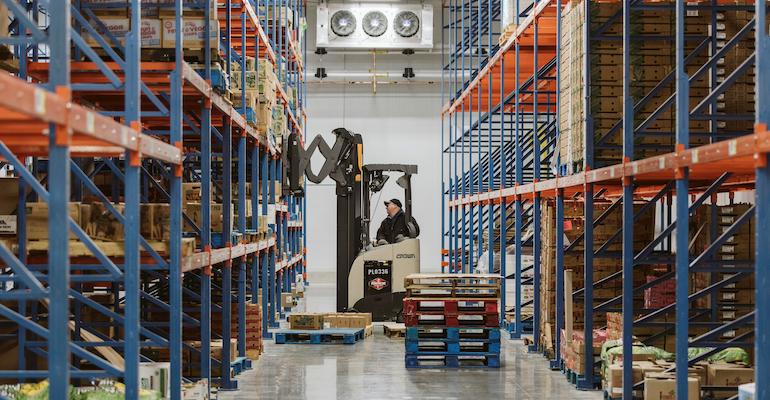
SN: This winning recipe, you said, underpins five strategic priorities for SpartanNash in 2022: creating a people-first culture; elevating execution to win the day; transforming the supply chain; acting on insights to optimize customer and product portfolios; and launching customer-centric, innovative solutions. Can you tell me about each of these priorities?
SARSAM: There’s a direct linkage to the three core capabilities, as you can probably tell.
• Creating a people-first culture.
I talked about the ‘people first’ culture. There’s a great deal of work that we’re doing to make sure that our people are well-trained and we're increasing the offer — not just the monetary offer, which is critically important, but also what do people feel when they’re at work, what kind of organization do they want to be part of and what are the opportunities for growth personally and professionally in our organization? We spend a lot of time on that. We spend a lot of time on recognition of how our team is performing. Our team has been been heroic, and we want to make sure we salute that and thank them early and often. So we have a lot of institutions in place to do just that, going out to the field, thanking people, bringing people into events to thank them. We’re spending a fair amount of time and effort on the recognition part, which we think really matters to folks in choosing a career. So creating a people-first culture is the critical first underpinning of our overall strategy.
• Elevating execution to win the day.
Elevating execution to win the day speaks to the base operations that we run. We run a complicated operation, everything from procurement through warehousing, break-bulk transportation, running stores and the merchandising support we provide for a lot of our customers. All those things are complicated operating endeavors. If we elevate our execution, we know it’s good for the company, good for our customers and, of course, good for their customers. So being a great operator is important in this business. That’s fundamentally what we do. We’re going to look for ways that we can train people and get visibility to those items that help us elevate our execution to win the day.
• Transforming the supply chain.
Transforming supply chain speaks specifically to that part of our organization, the warehouse and transportation part of our business. That business also, as you know, is a tough, tough environment. And you’ve got all of the elements of what has gone on these last couple years that have made it more difficult. The fundamental one is getting the right people into the organization, which I talked about a minute ago. In addition to that, there are other complicating factors in our business. As manufacturers and retailers are looking for growth, they’re looking for new ideas. They’re looking for what is manifest as a great deal and also more SKUs. So I’m thinking about how do I efficiently handle what is becoming a more complicated business, and how do I serve the customer first and foremost and find a way to do that efficiently? So we’re looking at both process work with our frontline employees as well as technology solutions — largely IT solutions early on — that help us to become more efficient and effective. And then in the longer run we’re looking at what are other types of tools, automation tools, that can make us more effective and efficient in the future.
• Acting on insights to optimize customer and product portfolios.
In terms of insights that optimize the customer product portfolios, I on that a bit when we talked about bringing insights to our customers. There’s just so much ground here. You think about really understanding consumers and what those eating habits are going to be and where people are moving to. For example, there has been a long trend of people moving from food-at-home to restaurants, or food-away-from-home. That trend reversed itself couple years ago and has moved back more slowly than we estimated. We thought it would be that, once restaurants found their footing again, people would start going back to their previous habits pretty quickly. But it has been really, really sticky in the favor of grocery stores of course.
And customers still have habits, needs and desires that are changing and evolving in that setting as well. There’s still an ever-growing food-away-from-home [demand], and I always think about the fundamental categories that have driven consumer behavior with food in the last quarter of a century. It’s about health and wellness, convenience and indulgence. And customers are looking for those things in ever-increasing ways. They want to have great meals they can prepare very quickly at home — that middle ground between the restaurant and food-at-home. They’re looking for really great expressions and indulgent foods that they can find and be delighted by — new ideas. And convenience is king. People are eating on the go and looking for things that can work for them very simply and be very straightforward. So that makes us rethink about our overall offering in our stores. And because we are a retail operator, we can bring those insights directly to our customers, the 2,100 independent grocers that we serve.
• Launching customer-centric, innovative solutions.
Launching customer-centric innovation, or innovative solutions, is really related that previous point. If we have the insights that can help optimize our business, then how do we actually take that next step to operationalize those insights and bring them to life with our customers.
Sarsam noted that SpartanNash-operated stores are working to enhance their online grocery offering.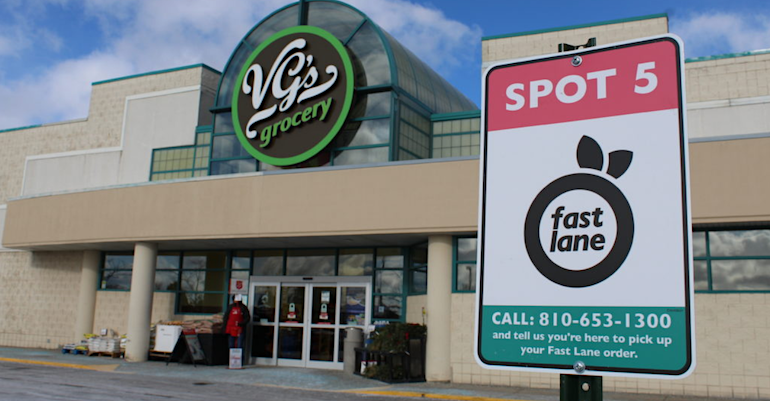
SN: You talked about the importance of people. Since you took the reins as CEO, SpartanNash has named a number of new c-suite executives, including chief merchandising officer, chief marketing officer, chief legal officer, chief strategy officer, chief supply chain officer and chief financial officer. How does this play into SpartanNash’s strategic plans?
SARSAM: Well, we’re changing the way we’re running the company — I think in a really exciting way — and the capability to make those changes has to come from the top. I recognized early on that there were some gaps in that, and so we began the process of bringing in the kinds of energized, extraordinary leaders who can actually lead a people-first culture and some of these other changes that we talked about. So it’s changing the way the company is run, it’s changing in a really positive way. Great leaders bring on great new people as well. So we have this cycle of bringing people here who are excited about joining the team. It’s new mission that we’ve described a little bit earlier, and it has been a great new day for us with these moves.
SN: Last month, SpartanNash’s board named three new independent directors, and the company said that after its upcoming annual meeting, eight of the board’s nine directors will be independent, with five appointed in the last four years. What does that bring to the table?
SARSAM: Board refresh is an important component of a company refresh. The company has had a long in history of a really fine board, and they’ve had great experiences from a variety of different disciplines. The board wanted to make sure that they got through these couple of transitions — a new CEO and the pandemic — and, when that was complete, there were some of the board members who were ready for that transition. And I think that the new board members we brought on are extraordinary. Their skills are above reproach in terms of what they can bring to our company, and they will help us as we think about these next steps in our future as well. So I’m really excited about the quality of the folks that we’ve brought onto the board recently.
Last July, SpartanNash launched a micro-fulfillment center in Caledonia, Mich., but Sarsam said the project is on hold as the company further develops its e-commerce services.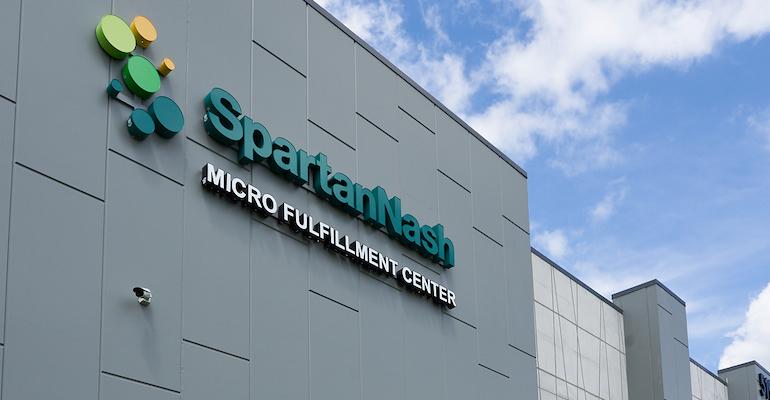
SN: Now let me shift to everyone’s favorite topic: e-commerce. How do you see the rapid consumer uptake of online grocery service as changing the game for food distributors and retailers?
SARSAM: E-commerce, broadly, has been accelerating at breakneck speed for 20 years. It has come to food a little bit later than it to some other items, for obvious supply-chain reasons. I think we have a lot to learn yet. We have a lot to learn in everything from click-and-collect to other components of last-mile work. We are very much still in the learning phase. We obviously got nice boost during the pandemic, when people were ordering more at home. But we are restlessly dissatisfied with our current capability there and are eager to learn more and really develop that as a great option for all of our customers.
SN: In that direction, last July, SpartanNash launched its first micro-fulfillment center in Caledonia, Mich. How is that going, and are there plans for more of these facilities to support Fast Lane pickup and delivery?
SARSAM: In terms of the plan, I would say the micro-fulfillment center is essentially on hold right now. I think we have more work to develop our total offering before we get into the kind of macro efficiency you get from a micro-fulfillment center. So we’re more focused on right now on what we offer the customer and making that easy for them and efficient for us. So we put the micro-fulfillment center on hold for a bit.
SN: Are you looking at automation technology for that? I think when it was announced, they said it was still manual picking.
SARSAM: I think that will ultimately be the solution. When the time is right, there will be more automation as we require.
SN: Let’s look back a bit. You’ve been SpartanNash’s CEO for about a year and a half. What has it been like moving from a primarily CPG background to grocery distribution and retailing?
SARSAM: It has been awesome. As a CPG person in the food [wholesale/retail] industry, there has been a ton of learning for me. The main thing I’ve learned is that there are really terrific people who give their life to this business, and it’s inspiring. I love the opportunity to spend time both with our internal associates and with our customers and the work that they do, which is so important to our communities. I’ve worked in large CPG companies, and they had large armies of people. The common ingredient, you know, is we had that same sense of vocation about what we did. So you find the commonality that’s the connecting factor. You’ve got great people, folks who want to do what’s right for their communities, their business, and they have that same sense of vocation. So it has been a terrific ride.

